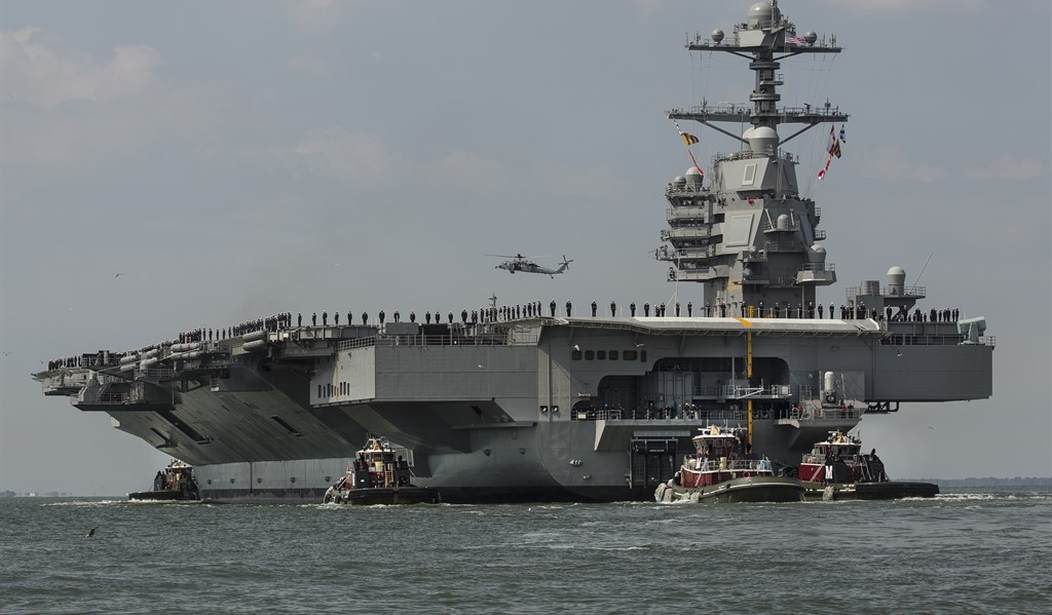Yes, I know that I don’t often write on military matters. But I couldn’t resist wading into the great aircraft carrier debate that has been raging for a decade or more.
At issue is this question: Are aircraft carriers obsolete now that weapons exist that can take them out?
China, in particular, has invested heavily in ballistic missiles that purport to be able to sink an aircraft carrier from as far away as 2500 miles using the DF-26 missile. Furthermore the Chinese have an extremely effective range of missiles to perform the A2/AD mission–anti-access/area denial.
A2/AD is the core of China’s strategy to challenge US supremacy in Asian waters and by extension in the Asian theater. If we can’t enter the area, we can’t strike without using ballistic missiles, which is unlikely to be seen as a viable strategy–and there is just no way that we have enough missiles to seriously dent China’s power without resorting to nuclear weapons.
All this backs up the “aircraft carriers are obsolete” argument.
It’s past time to put the companies behind aircraft carriers to work building something else: smaller, cheaper naval vessels that would present a far less tempting target to China, Russia, Iran, and others, writes Timothy Noah. https://t.co/ekoHZJBo3H
— The New Republic (@newrepublic) June 1, 2023
And, in my judgment, none of this is persuasive. I am hardly enamored of the procurement practices the US Navy has used to acquire the next generation of Ford-class carriers, and fear they may never live up to the promises we have been given. But the platform itself is of obvious utility for a lot of reasons.
First and foremost is the obvious: while a great power/near-peer war is quite possible, experience shows that the overwhelming majority of conflicts the United States engages in have never been against military peers. And aircraft carriers are exceptional force projection platforms in almost any scenario we are likely to face short of all-out war with China.
Secondly, the argument used against aircraft carriers in such a conflict applies to every single other naval asset the US deploys–that is the point of the A2/AD strategy. Deny access to US military assets in the Chinese sphere of influence. I doubt anybody knows if the US Navy could adequately defend itself against a Chinese strike on a naval fleet–that’s why they play the game, so to speak–but if not every single ship the navy has is quite vulnerable.
Now it is true that there is a numbers game–the Russians famously relied upon numbers over quality–and despite the failure of the Russian strategy of weight and quantity, there is a good argument to be made for having larger numbers of less capable platforms to ensure redundancy. Frankly I think we should have the same high/low strategy with carriers and submarines as we do with aircraft.
Aircraft carriers are expensive, and the money could buy a lot of other ships. But even the bloated Ford-class carrier at $13-15 billion would only buy you 3-5 of the next generation DDG(X) destroyer, and any sane person would want a carrier over 3-5 destroyers. Add the air wing and you might eak out another two destroyers, maybe 3. Still no comparison.
The striking power is vastly greater, and would scare the crap out of anybody rational.
Let’s consider the vulnerability argument from a different point of view: compare the carrier to a tank. The Ukraine war has led people to wonder if the tank’s day is done, and the argument is similarly flawed. Yes, tanks are vulnerable. In fact, any weapons platform is vulnerable. This is, after all, war where breaking things and killing people is the tool used to impose our will.
But tanks are still useful, if not all-purpose vehicles. You use them where they work well and use tactics that maximize the benefits and minimize the cost. Russia has done the opposite, and the US is watching. There is a reason why Ukraine still wants tanks: they are extremely useful and powerful weapons.
In World War I infantry were mowed down mercilessly, because nobody had adapted strategy or tactics to maximize their use and minimize their vulnerability. Many people assumed that after the disaster of WWI war itself would become obsolete because infantry were so vulnerable. War was even “outlawed” by the The Kellogg-Briand Pact of 1928.
How did that work out? War is with us still, I am afraid, as are infantry. New tactics were developed and the practice continues.
Nuclear weapons were supposed to eliminate the need for massive conventional militaries. Again, no. Didn’t happen.
The simple fact is that control of the seas is more important today than at any point in human history, and nothing controls the seas like a supercarrier. They are huge, expensive, very clunky, and more vulnerable than in years past. They are also vastly more capable of damaging the enemy when and where it counts. During operation Iraqi Freedom the Navy flew about 9000 sorties, of which about 5500 were armed missions–not all of which struck targets, obviously.
Still, it’s difficult to imagine using cruise and ballistic missiles as a replacement for what aircraft can do.
I just don’t buy the “Aircraft carriers are obsolete” argument. Until we can replace the utility of mobile airbases that have the firepower to devastate an enemy’s military en masse, I see nothing that can easily replace them. Cheaper ships can be bought in larger numbers–but not in sufficiently larger numbers to replace the striking power.
Losing an aircraft carrier or 3 would really suck, and lead to the kind of loss of life that America hasn’t faced since Vietnam. But that is inevitable if we go to war with China. A war in the Pacific would be more along the lines of a World War than a small regional conflict. It would be a disaster for all concerned.
Such wars are fairly common in world history, but not so much in recent history because the costs are so astronomical.
This is an argument for avoiding the war if at all possible, and not for disarming ourselves. It is also an argument for the development of strategies and tactics that will maximize power projection and minimize risk–including developing aircraft capable of striking from a longer range than current platforms.
Rather than focusing on replacing the aircraft carrier, reformers should focus on the hideously clunky and broken procurement system. What we have now is a disaster, and needs reform.








Join the conversation as a VIP Member